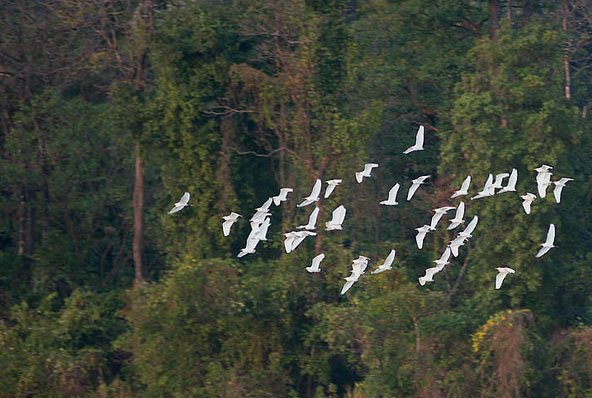Birding In Dibang Valley
Much of the Mishmi Hills comes under the Dibang Valley district of Arunachal Pradesh. The Dibang Valley district is named after the Dibang River. Mishmi Hills are on the Northeastern tip of India, in central Arunachal Pradesh and are a southward extension of the Great Himalayan ranges and its northern and eastern parts touch China. These hills are divided into 2 sections – the flood plains of tributaries of Brahmaputra river and the Arunachal Himalayas consisting of snow-capped mountains, lower Himalayan ranges and Shivalik ranges. This hilly area falls in the Dibang valley and is characterized by steeply sloping landform, sub-tropical evergreen forest and high rainfall.
With around 6000 species plant species, 100 mammals and over 600 bird species, Mishmi is a heaven for nature lovers. Some of the highlight bird species at Mishmi consist Sclater’s monal, Blyth’s Tragopan, Temminck’s Tragopan, chestnut-breasted partridge, Ward’s trogon, Red-headed Trogon Dark-sided thrush, Green Cochua, Purple Cochoa, Rusty-bellied and Gould’s shortwing, Beautiful Nuthatch, Mishmi Wren-babbler, Chevron-breasted Babbler Fire-tailed myzornis, 3-4 parrotbill species, Grey-headed bullfinch and so on.
Highlights:
- Photography tips & expertise
- Assistance in bird-watching and bird identification
- Knowledge sharing sessions (We urge our participants to share their knowledge and experiences so that everyone learns.)
- Trek through a mix of Assam valley Tropical Rain forest and North Indian Tropical Moist Deciduous forest.
Things to keep in mind before traveling
- Every tourist visiting Arunachal Pradesh needs to obtain an Inner Line Permit and a Protected Area Permit which can be collected from Delhi, Kolkata, Guwahati or Tezpur airports.
- Leeches are everywhere in Namdapha and in large numbers. Carry protective gear.
- To really get the most out of a Namdapha visit, camping inside the Park at Hornbill, Bulbulia, Haldibari is a must.
- Rain is never predictable, give yourself some extra days to make sure that a trip is not wasted.
- Locals are friendly and helpful. Be patient as not everyone will know fluent Hindi or English.
- Most cell phone networks don’t work well, so inform your family or friends about your whereabouts whenever possible.
- Don’t forget to carry some ready to cook food packets or instant noodles if you’re strictly a vegetarian.
- Carry extra batteries, power banks and most importantly warm clothing.
- Keep at least a couple of extra days in hand in case of any problems like landslides and bad weather on your way.
Approach to the Mishmi Hills area is from Sadiya Ghat which is on the north of the Lohit River. Sadiya Ghat is reached by river ferry from Saikhoa Ghat which is about 70kms from Tinsukia town in Assam. Roing town is 65 kms from Sadiya Ghat and is the last big town in Mishmi Hills trip. Dibang Valley Jungle Camp is 12 km, and Mayodia Pass is 56 kms from Roing and Hunli is another 44 kms on the same road. The road is black-topped and motorable. Landslides and washed away bridges are a feature of the area.
Mid-September To April Is The Best Time To Take This Trek
Day 1: Delhi/ Dibrugarh: Arrive afternoon at Dibrugarh airport, assistance by Aborcountry member, transfer to beautiful Colonial Tea Garden Bungalow turned into a Heritage Cottage. Overnight Tea Bungalow.
Day 2: Dibrugarh/ Miao/ Namdhapha: Morning after English breakfast drive 5hrs to Miao, the Sub-divisional headquarter of Changlang Dist. And the gateway of Namdhapha National Park and Tiger Reserve, continue drive inside the park 25 kms to Deban the last driving point. Overnight Forest bungalow or Tent
Day 3: Namdhapha in and around: Whole day bird around Deban area beside Noa-Dihing River. Overnight Forest bungalow or Tent.
Day 4: Namdhapha/ Haldibari: Morning after breakfast trek and bird (6kms) to Haldibari, cross the Noa-Dihing river on boat. Pack lunch on the way. We will camp at Haldibari. Overnight Tent
Day 5: Haldibari/ Hornbill: Morning trek to Hornbill (5 kms) bird around on the way, lunch on the way. Overnight Tent.
Day 6: Hornbill/ in & around: Today bird around Hornbill and stay the night at Hornbill in Tent.
Day 7: Hornbill/ Bulbulia: Today we will trek to Bulbulia (3kms) and stay the night in Tent.
Day 8: Bulbulia/ Haldibari: Trek back to Haldibari (8 kms). Overnight Tent.
Day 9: Haldibari/ Deban: Trek back to Deban, cross the Noa-Dihing river. Overnight Forest bungalow or tent.
Day 10: Deban/ Digboi: Morning drive to Digboi Oil Refinery in Assam. Digboi Oil Refinery is the first Oil field of India, visit the Oil Museum, World War-II cemetery of the allied forces. Overnight Digboi Oil Field Bungalows or Tourist Lodge.
Day 11: Digboi/ Kaziranga: Morning drive to Kaziranga National Park and Project Tiger. Home of Great Indian One horn Rhinoceros. Enroute visit the historical city and the capital of Ahom Kingdom who ruled the Brahmaputra valley for over Six hundred years. Overnight Wild Grass Resort.
Day12: Kaziranga: Early morning drive to to the Park for Elephant Safari to have closer encounter with Rhino, drive back to resort for breakfast. Whole day jeep safari inside the park. Overnight Wild Grass Resort.
Day 13: Kaziranga: Birding at Kaziranga National Park. Overnight Wild Grass Resort.
Day 14: Kaziranga/ Nameri National Park: Drive to Nameri National Park & Project Tiger. On arrival check-into Camp. Afternoon cross the Jia Bhorali River to enter into the Park, Trek around and back to Camp later. Overnight Nameri Eco Camp
Day 15: Nameri National Park: Early morning walk around the Camp, later after breakfast raft down the river for. Afternoon back to camp later bird inside the park. Overnight Eco Camp.
Day 16: Nameri/ Guwahati: Early morning drive to Guwahati airport, on arrival check-in for flight to onward destination.





